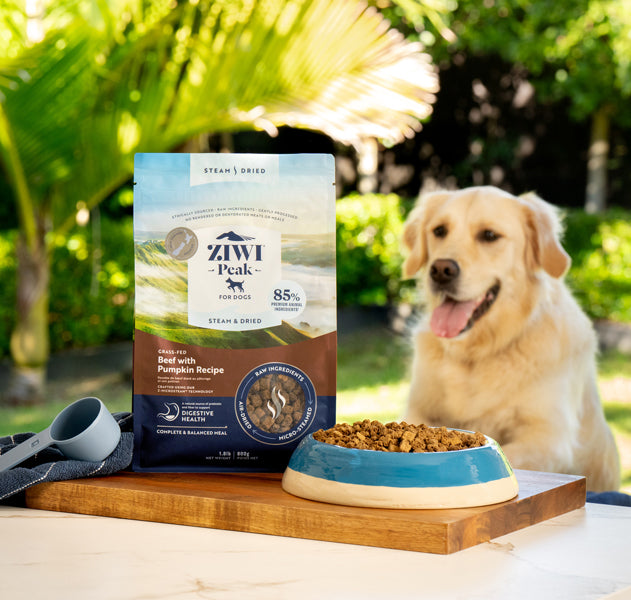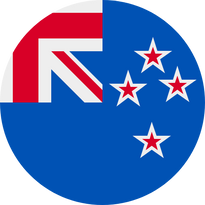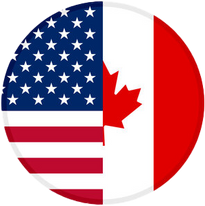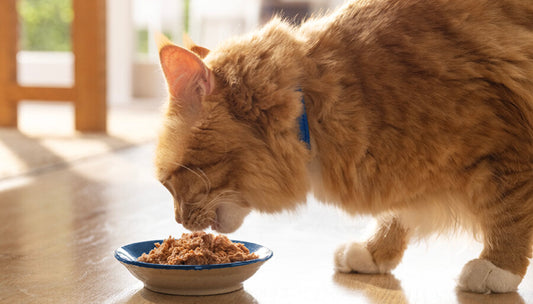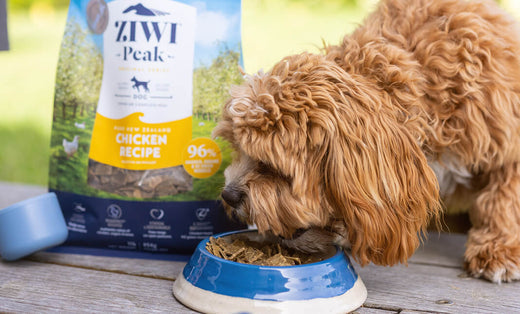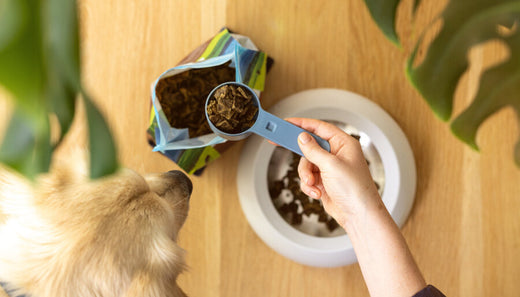We know it’s hard to say “no” to your furry friend as they look up at you with those puppy-dog eyes, begging for a little taste off your plate or another helping of food...
What many pet guardians don’t realise, however, is how quickly dogs can become overweight if they’re eating too much (especially too much of the wrong food) - and also the consequences this has on their joints and overall health.
Below we explore the best dog food for weight loss and offer some guidance for helping your dog maintain a healthy weight so they can live their best, happiest life.
Low calorie dog food - what’s the deal?
There are lots of ‘diet’ foods out there claiming to help your dog lose weight. They may have less calories, but they also have more fiber and carbohydrates than what your dog needs.
Carbs (such as rice) are cheaper than protein, so they enable manufacturers to bulk up their products and sell them at a competitive price. The problem with these low-calorie diets is they don't give your pet the nutrients they need to thrive.
They’ll end up going to the bathroom more frequently because of the excess fiber, and feeling unsatisfied (despite eating their regular amount of food) because they’re not getting enough protein. If your dog isn't exercising enough, you may also find these products cause your dog to put on weight.
The best weight loss dog food
Cutting out processed, high-carb foods and switching to a high-meat diet is the first step in helping your dog lose extra pounds and maintain a healthy weight.
Dogs are carnivores. Their bodies are designed to easily digest and absorb nutrients from meat, whereas they don’t have the digestive enzymes needed to break down carbohydrates.
They thrive on a protein-based, meat-rich diet that includes meat, bones, fat and organs. Not only are these biologically-appropriate foods extremely appetizing, they also keep your dog feeling satisfied (which could mean less begging!).
The next best thing to a raw diet is ZIWI Peak® - you’ll find 96% meat, organs, seafood and bone in all of our air-dried recipes, without the added carbohydrates or sugars.
ZIWI Air-dried Dog Food
Our Original Air-dried Mackerel & Lamb Recipe for dogs feature wild-caught mackerel and free-range lamb, organs, Bone, and New Zealand Green Mussels, this grain-free dog food delivers nutrition with a mouth-watering taste for all dogs.
Finding the best weight management dog food
Now you know what you should be feeding your dog to help them lose weight, let’s look at how much you should be feeding them.
This is where things get a little technical. It’s time to crunch the numbers and follow a gradual decrease in food to help your dog reach their ideal weight, following these 4 steps:
- Choose a ZIWI Peak recipe (either air-dried or wet)
- Slowly start transitioning to the new ZIWI diet (see tips here)
- If your dog is slightly overweight, start feeding them the amount recommended for their ideal weight, not their current weight (use our handy feeding calculator here). If your dog is significantly overweight, you’ll need to reduce their food intake slowly, in very small increments, before you’re able to drop it further in line with the recommendation for their ideal weight
- Once they reach their ideal weight, keep feeding your dog this amount ongoing!
It’s important to note that our feeding calculator is a helpful tool, but you’ll also need to consider your dog’s breed, activity levels, and individual metabolism. You can learn more about calculating your dog’s food intake here.
Diet is only one piece of the (health) puzzle
Diet is a huge factor in weight management, but it’s not the only factor. A lack of physical activity also leads to weight gain.
Studies have shown the odds of being overweight are greater for dogs that exercise less than once per day - so it’s super important to ensure your dog is getting the physical exercise they need.
There are going to be days when life takes over, and despite your best efforts, your furry friend doesn't get a chance to run around. But this is where you can get creative!
Whether it’s a puppy play date, a quick run around the neighborhood before work, or even dropping them off at doggie daycare, your dog will be much happier and healthier with regular exercise.
If your dog is severely overweight, start with a few short walks and build up their fitness. Swimming is also a great way to exercise bigger dogs, without adding extra pressure on their joints.
To help your dog maintain a healthy weight, focus on getting the basics right:
- Feed them a calculated amount of nutrient-rich, unprocessed food
- Ensure they get plenty of exercise
- Give them lots of love and support - even if it means saying “no” to those extra treats for a while!
Once the basics are sorted, you should also notice a boost in your dog’s energy levels. They’ll be healthy, happy and bursting with vitality.
To learn more about the ingredients in ZIWI Peak, click here.
Sources:
- https://healthypets.mercola.com/sites/healthypets/archive/2012/08/17/low-fat-diet-for-dogs.aspx
- https://www.cambridge.org/core/services/aop-cambridge-core/content/view/01E2D6FBCDD05069E3557C10A1CC5945/S2048679017000064a.pdf/overweight_dogs_exercise_less_frequently_and_for_shorter_periods_results_of_a_large_online_survey_of_dog_owners_from_the_uk.pdf
- https://onlinelibrary.wiley.com/doi/abs/10.1111/j.1748-5827.1970.tb05621.x
- https://dogsfirst.ie/health-issues/feed-fat-dogs-fresh-not-less/
- https://www.darwinspet.com/health-issues/weight-loss-dogs/
